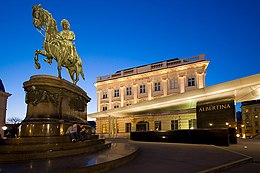Albertina museum
 |
|
| Established | 1805 |
|---|---|
| Location | Albertinaplatz 1, Vienna, Austria |
| Coordinates | 48°12′15″N 16°22′07″E / 48.20417°N 16.36861°E |
| Type | Art museum |
| Founder | Duke Albert Casimir |
| Director | Dr. Klaus Albrecht Schröder |
| Public transit access | U1, U2, U4 (Karlsplatz) |
| Nearest parking | Operngarage |
| Website | www |
The Albertina is a museum in the Innere Stadt (First District) of Vienna, Austria. It houses one of the largest and most important print rooms in the world with approximately 65,000 drawings and approximately 1 million old master prints, as well as more modern graphic works, photographs and architectural drawings. Apart from the graphics collection the museum has recently acquired on permanent loan two significant collections of Impressionist and early 20th-century art, some of which will be on permanent display. The museum also houses temporary exhibitions.
The Albertina was erected on one of the last remaining sections of the fortifications of Vienna, the Augustinian Bastion. Originally, the Hofbauamt (Court Construction Office), which had been built in the second half of the 17th century, stood in that location. In 1744 it was refurbished by the director of the Hofbauamt, Emanuel Teles Count Silva-Tarouca, to become his palace; it was therefore also known as Palais Taroucca. The building was later taken over by Duke Albert of Saxen-Teschen who used it as his residence. He later brought his graphics collection there from Brussels, where he had acted as the governor of the Habsburg Netherlands. He had the building extended by Louis Montoyer. Since then, the palace has immediately bordered the Hofburg. The collection was expanded by Albert's successors.
The collection was created by Duke Albert with the Genoese count Giacomo Durazzo, the Austrian ambassador in Venice. In 1776 the count presented nearly 1,000 pieces of art to the duke and his wife Maria Christina (Maria Theresa's daughter). Count Durazzo, who was the brother of Marcello Durazzo, the Doge of Genoa – "wanted to create a collection for posterity that served higher purposes than all others: education and the power of morality should distinguish his collection...." In the 1820s Archduke Charles, Duke Albert and Maria Christina's foster son, initiated further modifications to the building by Joseph Kornhäusel, which affected mostly its interior decoration. After Archduke Charles, his son Archduke Albrecht then Albrecht's nephew Archduke Friedrich, Duke of Teschen lived in the building.
...
Wikipedia
